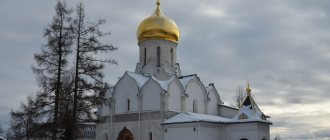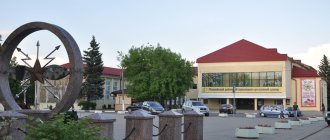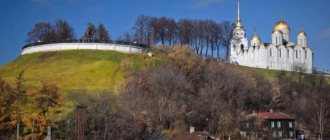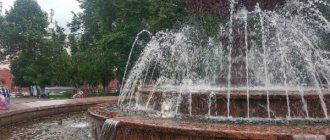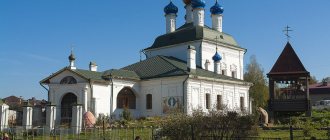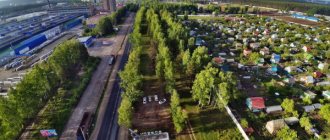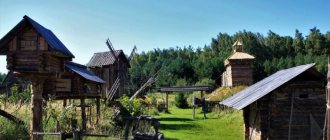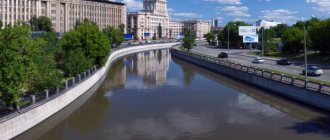Belgorod is located on the right bank of the Seversky Donets. Initially, the fortress was located on the high left bank, but it was captured and destroyed.
Probably, since then there has been confusion about the year the city was founded. According to some sources, it is 400 years old, and according to others, 1000. The central part of the city is an area of historical sites and architectural monuments.
Interesting cities near Belgorod, archaeological excavations, historical monuments and natural beauty - in a detailed guide to the sights of the Belgorod region.
Getting to know the history of the city
Belgorod - “white city”. There are 2 similar versions of why it was called that:
- In the 17th century, the fortification was erected from white stone.
- The city was built on a chalk mountain - Belaya.
And there is fierce debate among historians about the date of the city’s founding. One of the points of view is the beginning of the construction of a defensive fortress on the site of the Seversky settlement (settlement of the Eastern Slavs) in 1596. Tsar Fyodor Ioannovich ordered its construction on the mountain on the right side of the Seversky Donets River. But she didn't last long.
This place was located at the intersection of modern Kalinin and Studencheskaya streets.
The site for the construction of the second fortress was the left bank. Now this area is called the Old Town. Since 1650, the main part of Belgorod was again located on the right bank. Since 1727, it became the center of the Belgorod province, and 52 years later - a district town of the Kursk province.
The city survived attacks by the Crimean khans, Polish-Lithuanian feudal lords, and an assault on the fortress by Zaporozhye Cossacks led by Yakov Ostryanin. The buildings had to be rebuilt. After the advent of Soviet power, it was part of Ukraine for some time and even served as its temporary capital. Later it was annexed to the White South, a territory controlled by the White Guard Volunteer Army.
Archaeological research carried out in Soviet times allowed Academician Rybakov to conclude that the settlement appeared in the 10th century. In 1995, after the government adopted a resolution, Belgorod residents celebrated the 1000th anniversary of the city.
During the fighting and occupation (October 24, 1941 - August 5, 1943), not a single intact building remained in the city. The Nazis practically exterminated the indigenous inhabitants by shooting them in the park, tormenting them at the Gestapo, and burning them in a reed factory.
Bogdan Khmelnitsky Avenue
Locals call it “Bogdanka”. The federal road "Crimea" passes through it.
Chapel-rotunda in honor of the 2000th anniversary of the Nativity of Christ
The structure welcomes travelers arriving in the city from the north. An angelic figure meets them and blesses them. Along the entire length of the avenue there are many monuments, squares, and parks.
Monument to Equal-to-the-Apostles Prince Vladimir
Address : Vatutina Ave., 6
The opening of the monument was justified by the dates of two great events: the 2000th anniversary of Christianity in Rus' and the 55th anniversary of liberation from the German invaders. Prince Vladimir is considered the founder of the settlement that became the foundation of the city.
Even the lack of strict evidence of this fact does not bother the townspeople. Some historical trend has reached our days and has become established in the appearance of the copper figure of Vladimir.
The monument is interesting for its artistic and architectural purposes. In one hand the prince holds a cross, and the other hand rests on a shield. An artistic image of a protector from all aggressive invasions and spiritual encroachments appears.
People's Boulevard
Part of the territory is occupied by the Central market. There are also a stadium, shopping centers, and a city lyceum, the history of which dates back to 1860. And how many original monuments are there on the boulevard that attract the attention of tourists and want to take pictures with them:
The sculpture of the First Teacher was installed in the courtyard of the Lyceum
Not only visitors, but also city residents strive for the Sundial. Lovers come to them on dates. In the dark, the entire Milky Way is visible on the dial, allowing you to study the zodiac constellations.
Sundial in Belgorod
The monument to the janitor was erected to commemorate the role of these workers in the cleanliness of the city. Belgorod is one of the cleanest cities in Russia, which has been repeatedly noted by the government. The bronze sculpture weighs 175 kg
Chelnoki - a monument dedicated to the first entrepreneurs. Installed near the central market. Its height is 3 meters
Speaking about unique sculptures, it is necessary to mention the monument to an honest traffic cop, dedicated to the guard Pavel Kirillovich Grechikhin. He was distinguished by his crystal purity, issuing fines to all violators - relatives, friends, wife, even his boss. In 2016, the sculpture changed its original installation location and was assigned to a new address - the intersection of Korochanskaya and Volchanskaya streets.
Monument to an honest traffic cop
Pushkin Alley
After taking great selfies against the backdrop of the city, you can go for a walk along Pushkin Alley, located not far from the monument to Prince Vladimir.
Pushkin Alley
It is part of the BSTU campus. Shukhov, and here you can see another landmark of Belgorod: a concrete fence decorated with graffiti. Architectural students decorated it with original illustrations to the works of the great Russian classic Alexander Pushkin.
- Address: st. Akademicheskaya, 1 V.
- Cost of visiting: free.
- Opening hours: 24 hours a day.
Smolensky Cathedral
The story of the appearance of the temple begins in 1703. In the chronicles, records were found about an unusual sign that appeared before the watchman of the Belgorod regiment. Looking at the gates of the fortress, he saw that a ray flashed on the icon of the Smolensk Most Holy Theotokos, and from it a candle ignited. In 1705, a wooden church was built on that site. 1727 - the beginning of the laying of a stone two-story church in the Baroque style with the participation of the Archbishop of Belgorod.
The Smolensk Cathedral in Belgorod is one of the oldest surviving churches
The temple was on the verge of destruction twice. During the war years, it was severely damaged by artillery shelling and lost its bell tower. After the war, the damaged buildings were used as warehouses. Twice they tried to blow it up as a building that could not be reconstructed. But the temple survived and they finally decided to restore it for the organ hall. Since 1991, services have been resumed there.
The Smolensk Cathedral attracts visitors with the Hodegetria icon of the Mother of God kept there. Otherwise they call her “Guide”. She is over 300 years old. Every month, a car with an icon drives around the city to prevent all troubles.
Temple address: Civil Avenue, 50.
Cave of Joseph of Belgorod and the building of the Belgorod Metropolitanate
This is a unique cultural and historical complex. In the building of the metropolis there is the Holy Trinity Church, a crypt with the relics of the holy martyr Nicodemus, as well as a separate temple with the relics of other saints. Above the cave of St. Joseph, the heavenly patron of the Belgorod land, there is a glass dome with a statue of an angel with a cross. His relics are also located here.
Cave of Joseph of Belgorod and the building of the Belgorod Metropolitanate
Important! This place is considered a place of prayer, and cases of miraculous healing of people attract many pilgrims here.
- Address: Svyato-Troitsky Boulevard, 24.
- Cost of visiting: free.
- Opening hours: daily from 9:00 to 17:00.
Assumption-Nicholas Cathedral
This is the oldest building in Belgorod. Construction of the city's first stone building began in 1690, replacing a wooden church.
Peter I donated 100 rubles for the construction of the temple. At that time it was a huge amount. For more than 200 years, a letter written personally by the emperor was kept in the cathedral.
The consecration of the Assumption-Nicholas Cathedral took place in 1703
Extensive restoration work was carried out after a fire in 1759, as a result of which the roof was almost completely burned, the domes and iconostasis were damaged, and the walls inside the building were charred. Features of the cathedral architecture:
- unusual asymmetry of the layout;
- a single-tier bell tower (there were very few of these), but it has not survived.
During the years of Soviet power, it housed a prison for prisoners and a bakery. During the bombings during the war, townspeople took refuge in the safe basements of the cathedral. Since 1993, it was included in the Marfo-Maryinsky Convent. Ministries resumed there.
Address: Pushkin street, 9.
Cathedral Square
Cathedral Square is called the historical heart of the city. It is located next to Victory Park, the registry office building, a hotel, museums and a theater. In addition to the Eternal Flame memorial complex, the Zero Kilometer is also located here. This is a favorite place for tourists who rush to make a wish here and wait for some sign about whether their plans will come true or not.
Cathedral Square
In winter, a Christmas tree is installed on the square and a skating rink with artificial ice is installed, and fairs are held (hence the conclusion: winter holidays in Russia are no less interesting than abroad). In summer it is fragrant with flowers: colorful flower beds delight the eyes of townspeople and tourists every year.
- Address: pl. Sobornaya.
- Cost of visiting: free.
- Opening hours: 24 hours a day.
Transfiguration Cathedral
The cathedral is easily accessible from the train station. You can walk. It is located on Preobrazhenskaya Street, 63-B, near Cathedral Square.
Transfiguration Cathedral is more than 200 years old
The cathedral was consecrated in 1813 to commemorate the victory of the Russian people in the Patriotic War. A sign at the entrance tells about this. High ranks of the clergy paid attention to the temple:
- His Holiness Patriarch Alexy II celebrated the liturgy there;
- The temple was awarded a rare church award from His Holiness Patriarch Kirill.
Inside the cathedral, the rich paintings on the walls and multiple icons, and a large beautiful iconostasis are striking. It is worth mentioning the “Chernobyl Savior” icon, dedicated to the people affected by the disaster.
The cathedral contains the relics of St. Joasaph of Belgorod, which have been preserved almost completely. Every day, after the service of the water blessing prayer, they are opened for worship with the opportunity to touch the hand of the saint. They turn to him with a request for healing from an illness. For the period from August 19 to September 16, the relics are transported to the St. Joasaph Cathedral in Belgorod.
Several other shrines :
- Icon of the Mother of God “The Sign” . For a long time it was lost. It was discovered during the demolition of old houses in a terrible condition - the surface was covered with a layer of rust. It was placed under glass as an exhibit in the local history museum. Soon the staff noticed that the icon was gradually renewing itself - first the face of the Mother of God appeared, then the figure of the Child and the signature under the icon.
- The miraculous icon of St. Nicholas the Ratnoy , known for its miraculous stories. During one of the attacks, the Tatars abruptly stopped at the dam, seeing the abbot with an icon of St. Nicholas the Wonderworker. Then they turned around and began to run away. Many fell into the water with their horses and died. This happened in the village of Ustinka, Belgorod region. The relics are over 500 years old.
- Icon of Elijah the Prophet with a stone from the cave in which he prayed. The temple area is distinguished by its cleanliness, richness of colors, and paths made of paving slabs.
Exciting places for children
Undoubtedly, children will be pleased with their visit to the zoo and dino park. The zoo is located in a forested area. It has a fairly vast territory (25 hectares). The animals have spacious enclosures and heated wintering rooms.
"Grandma's Yard" at the Belgorod Zoo introduces domestic animals
The territory of the reserve is divided into special geographical zones. The variety of inhabitants is amazing. There are birds of prey, wolves, bears, sika deer, snakes, and a crocodile. It's fun to pose the monkeys. The artificial lake is home to waterfowl (ducks, swans, geese) and fish. Children enjoy watching them and feeding them. There are equipped recreation areas and playgrounds for children. Zoo address: Bogdan Khmelnitsky Avenue, 16a.
Another attractive place is the Dinopark, located in a pine forest. Life-size models of robotic dinosaurs will be remembered for a long time.
Belgorod Dinopark is the largest in Europe
It’s hard to part with this picturesque, spacious, comfortable, educational corner. Immediately at the gate, visitors are greeted by a huge dinosaur skull, on which children happily climb. The decoration at the entrance is a high arch and a huge gate in the form of a palisade. They can be seen from afar. And then - a huge seismosaur. If someone approaches him along the paths, he purrs and moves. There are other models of robots that can move, growl, move their paws, and breathe. They were made in the Czech Republic.
You can visit the Dinopark:
- The Dino Museum has interesting exhibits telling about different periods of the life of dinosaurs. The kids' favorite is a dinosaur skeleton with the opportunity to try to control it.
- 3D cinema showing cartoons.
- carry out excavations in a huge sandbox.
- in a store where you can buy souvenirs.
DinoPark
A year ago, Belgorod residents and guests of the city had the opportunity to travel back in time. Now, every time they visit DinoPark, citizens are transported to the era of dinosaurs. There are more than 90 life-size animal figures here. Some of them are even robotic: they can move and make sounds. A real Jurassic Park! On its territory there are cafes and themed photo zones, a museum and a cinema with a paleontological area.
DinoPark
Attention! From November until the beginning of April, DinoPark is closed.
- Address: st. Volchanskaya, 292 B.
- Opening hours: from 10:00 to 21:00, except Mondays.
- Ticket price: from 100 to 300 rubles, children under 3 years old - free.
Museum-diorama “Battle of Kursk. Belgorod direction"
The building was built in the form of an arc raised on a high plinth. The museum is small, but the diorama is made at a modern level. In terms of its size (1005 m2), it is the largest in Europe. The artists worked on painting the canvas for 2 years, taking consultations from the surviving participants in the battle. The plot is based on a tank battle near the village of Prokhorovka, which served as a turning point in the Battle of Kursk. Many of the characters in the film bear similarities to portraits of real participants in the battle.
Museum-diorama “Battle of Kursk. Belgorod direction"
In 2 halls, unique exhibits of the history of the war years are presented: weapons, documents, awards, personal belongings, photographs of battle participants. The open area is filled with military equipment.
Museum address: Popova street, 2.
Sights of Belgorod
So, having arrived at the Belgorod station, the first thing I did was order a taxi. Since I didn’t know the city at all, I asked the taxi driver to take me to a good hotel. At the same time, along the way, I asked him about where to go and what to see in the center of Belgorod. The taxi driver eagerly told me what attractions of Belgorod are located in the center. I followed his recommendations that same evening.
Since I only had one night and one morning at my location, I tried to see the sights of Belgorod as much as possible. Therefore, I want to share my experience with those who are interested in what to see in one day in Belgorod. I provide my list of Belgorod attractions with photos.
The main city square of Belgorod
I want to start my story about beautiful places in Belgorod with Cathedral Square. Our taxi ride took less than ten minutes and I got off near a hotel called Belgorod, which was located on Cathedral Square.
I am very grateful to the taxi driver for taking me to this particular hotel, as I really liked it. In addition, from the window in my room there was a stunning view of Cathedral Square.
But first things first. Cathedral Square is the main square of the city of Belgorod. As befits the main square of the city, the main city events are held here. Car traffic is prohibited on the square as it is a pedestrian zone. In addition, the area is paved with multi-colored tiles with very interesting patterns.
The sights of Belgorod are located around Cathedral Square. One of them is Holy Trinity Boulevard. It is a favorite place for walks among citizens and guests of the city. At the very beginning of the Holy Trinity Boulevard there is the Eternal Flame memorial.
On the opposite side of Holy Trinity Boulevard, Grazhdansky Avenue leads to Cathedral Square. It looks especially beautiful at night.
By the way, this is exactly why I took a taxi to the hotel from the train station.
I took a walk along Grazhdansky Avenue and it left me with a very pleasant impression. I was especially pleased with the large number of post-war buildings. And I even came across a building built in the 19th century.
The Belgorod Hotel, where I stayed, is also the hallmark of the city. And this is no coincidence, because its building, built in 1956, is really very beautiful.
From the windows of my hotel room I could clearly see the building of the Government of the Belgorod Region.
In front of the Government building there is a monument-stele “City of Military Glory”. By the way, Belgorod was the first city in Russia to be awarded the title “City of Military Glory” in 2007.
Opposite the Government building is the Belgorod Drama Theater named after M.S. Shchepkina.
The theater building looks very grandiose.
Next to the theater there is a Chapel in honor of the Holy Equal-to-the-Apostles Prince Vladimir. It was consecrated in 2015.
Gorsad Square
As I wrote above, from Cathedral Square you can go to Grazhdansky Avenue. It was along it that I went for a walk first. I didn’t have to look for the sights of Belgorod for long. After all, literally immediately my attention was attracted by a very bright and incredibly beautiful fountain.
A very picturesque path decorated with metal petals led to the fountain.
As I later found out, it was Friendship Square with an alley of twin cities. It was opened quite recently in 2012. But already in 2022 it was renamed City Garden. It is located in the courtyard of the Wedding Palace. The fountain that caught my attention is called Easter. Interestingly, it is a reconstruction of the first Belgorod fountain from the beginning of the 20th century. This is what this fountain looks like during the day.
But the central composition of the square is a forged tree and a navigation pole.
On the navigation post signs you can read the names of Belgorod's sister cities.
Forged wood is a symbol of friendly relations. As you can see, its metal roots go deep into the ground, which indicates a connection with cities.
A park stretches from the tree to the fountain.
It is decorated with granite pedestals with forged leaves.
The names of Belgorod's sister cities are written on the leaves.
Victory Park
To all those who find themselves in a situation similar to mine and wondering what to see in Belgorod in one day, I definitely recommend visiting Victory Park. The story about the sights of Belgorod without this park, in my opinion, is incomplete.
As you can easily guess from the name, the park is dedicated to the victory in the Great Patriotic War. This is symbolized by the memorials and monuments installed in the park. Victory Park itself is located on the banks of the Vezelka River.
Despite the fact that I reached the park already after midnight and took my walk in absolute solitude, it is worth noting that it was absolutely not scary. Since the park is well lit, it is very pleasant to walk along its paths even in the dark.
The next morning, I visited Victory Park again and saw another attraction that I had not noticed at night, namely the ducks in the river.
Having spent the night on a slab near the shore, they woke up and, to the delight of park visitors, began their swims through the water.
By the way, in the light of day, I examined other sights of Belgorod in more detail. For example, here on the banks of the Vezelka River there is a sculptural composition in honor of Saints Peter and Fevronia.
Next to the monument there are trees forged from iron, on which lovers hang ribbons and locks.
Belgorod State Art Museum
The sights of Belgorod are worthily represented by its museums. One of them is the Belgorod State Art Museum. Its bright and colorful building caught my attention on the way from the drama theater to Victory Park.
The museum displays a large number of exhibits. Among them there are works of painting, sculptural compositions, graphic and decorative works.
Museum-diorama “Battle of Kursk. Belgorod direction"
After walking through Victory Park, I crossed the road to the opposite side of the street. We can say that I was lucky, because without knowing it myself, I came across, perhaps, the main attraction of Belgorod. So the diorama museum “Battle of Kursk” appeared before my eyes. Belgorod direction". The museum is dedicated to the largest tank battle near Prokhorovka, which took place on July 12, 1943.
The museum building is built in the shape of an arc located on a high base.
Among other things, you can see military equipment here.
It is worth noting that the museum looks very beautiful at night.
But the main exhibition of the museum is the largest diorama in Europe, “Arc of Fire”. It is a canvas with an area of 1005 square meters. It depicts the Battle of Kursk. By the way, I really regret that I didn’t have enough time to visit her.
And if you go behind the diorama museum, you can see a monument to those who fell in Afghanistan. Interestingly, Belgorod is the first city to erect such a monument in 1995.
Belgorod State Museum of History and Local Lore
When listing beautiful places in Belgorod, it is worth mentioning Museum Square. It is interesting because it contains three attractions of Belgorod at once. Namely three museums. I have already talked about two of them. The third museum is the Belgorod State Museum of History and Local Lore.
The museum was opened as a branch of the Kursk Provincial Museum in 1924. He had to endure many trials, including during the Great Patriotic War. The museum was moved to its current building in 1991. But even before that, in 1963, the museum received regional status.
The exhibits presented in the museum tell about the history of the Belgorod region from ancient times to the present.
There is a memorial sign in front of the museum.
The inscription on it says that the sign was installed on the site of one of the four “entry” royal pillars, located on the northern and southern outskirts of the city and erected in the late 19th and early 20th centuries in honor of the stay of Catherine II and Alexander I in the city.
Smolensky Cathedral
When describing the sights of Belgorod, it is impossible to mention its temples and cathedrals, since Belgorod is an ancient Russian city with a rich history. Due to the fact that my walk around Belgorod turned out to be unplanned, I did not have time to prepare a route for the sights of the city. But still, I managed to see one cathedral quite well. It was the Smolensk Cathedral.
The Smolensk Cathedral is located near Cathedral Square. If you walk from the square along Grazhdansky Avenue, then literally after a few houses on the left side you will see the Smolensky Cathedral. It will be impossible to miss it, as its bright blue color undoubtedly attracts attention.
The Smolensk Cathedral was built in honor of the sign that occurred in 1703 from the icon of the Smolensk Blessed Virgin Mary. Its construction began in 1727. The history of the cathedral is described in great detail by an inscription on a metal plaque on the wall of the cathedral.
From what you have read, it is clear that the Smolensk Cathedral has experienced a lot over the years of its existence. It suffered desolation during the years of Soviet power and devastation during the Great Patriotic War. But in the end, the Smolensk Cathedral was restored and in 1994 it was consecrated again.
Literary Museum
Lovers of literature and ancient architecture will love this museum. Its location is a 2-story stone merchant mansion (the house of the merchant Selivanov) at 38 Preobrazhenskaya Street. The layout of the building is not standard. The building has been preserved in its original form, the stairs, stoves, and ceiling decoration have been restored.
Among the museum exhibits are:
- antique books;
- original manuscripts of famous writers (even Pushkin);
- objects associated with the names of Belinsky and Stankevich.
Belgorod Literary Museum in the former house of the merchant Selivanov
There is a separate room dedicated to oral folk art. In other rooms, visitors get acquainted with literature from different centuries, modern works, the history of journalism, exhibitions about cultural life, and presentations of new books. Literary evenings are held for them.
The Museum of Energy History of the Belgorod Region is located in the same building.
State Art Museum
The museum displays exhibits of paintings and graphics, sculptures, and icons. The collection is constantly replenished with items coming from exhibitions, purchased from authors, and donated. Work is underway to complete icon painting and artistic photography. The collection consists mainly of works from the 20th century.
Belgorod State Art Museum
The museum is located at 77 Pobeda Street (not far from the diorama). In addition to the services of a guide, you can use an audio guide by downloading the application to your smartphone. The exhibition hall hosts more than 15 exhibitions a year, lectures on fine arts, field trips, and the concert hall hosts creative meetings with artists and chamber evenings. The art salon offers a huge selection of souvenirs, handicrafts, and printed products.
Museum of Communications
In 2003, in honor of the 100th anniversary of the organization of the zemstvo telephone exchange, a communications museum was opened in Belgorod, containing more than 3,000 exhibits. Among them are:
- rare radios;
- teletypes;
- the first TV models;
- telephone sets from the world's leading companies;
- loudspeakers.
Museum of Communications in Belgorod
A curious feature of the exhibits is that they all work. You can get acquainted with the operation of the switchboard, modern means of communication, and even a list of subscribers of the telephone exchange in 1931.
Museum address: Glory Avenue, 126.
Open-air museum "BELGORODSKAYA CHART - MURAVSKY SHLYAKH"
The museum was created as part of the project of the BROO “Historical Society “Warrior” with the support of the Presidential Grants Fund.
The museum and recreational complex is located on the site near an archeological monument of the 17th century - a preserved section of the earthen rampart and town of the Belgorod area. The main exhibits of the museum are recreated examples of defensive structures of the 17th century; this will allow you not only to study history as the science of the past, but also to immerse yourself in the atmosphere of that time, to feel like a defender of one of the fortresses of the Belgorod region. All exhibits in the complex are interactive to one degree or another. To visit the museum, you do not need advance booking or a guide - the entire territory is provided with high-speed Internet, and the exhibition is equipped with a QR code system that will allow you to view a video tour, use augmented reality capabilities and complete interactive quests.
This is a place where everyone can immerse themselves in the history of the 17th century - during the construction of the fortified cities of the Belgorod region. If you are interested in the history of Russia and the Belgorod region and enjoy leisurely recreation in nature, then we are sure that our museum will become your favorite vacation spot.
Address: village Dragunskoe st. Kozhemyakina (15 km from Belgorod)
Museum website: https://history-park.ru/.
Where to go for fun
Quests are a genre of entertainment that is quickly gaining popularity in Belgorod. Experience an adventure in the style of Indiana Jones, rob a bank, get out of a blocked mine, unravel the mysteries of the old theater, experience a nightmare on Elm Street - all this and much more is offered by the organizers of the companies CityQuest (office site) and "Cache" (office site ).
Fans of outdoor activities will certainly enjoy Picnic Park (office site). There is more than enough entertainment here for the whole day. In the summer - bicycle rental, river boat trips along the Seversky Donets, a beach, a rope park, a children's playground, a crossbow shooting range and a laser tag area. In winter, a huge skating rink is filled, paintball battles are in full swing and snowball throwing competitions are held.
Rotunda in Belgorod
Lenin Park
It was updated in 2000 at the expense of sponsors - store owners. Projects from foreign park areas were used during the reconstruction.
Children's in Lenin Park
The park with an area of 240 thousand m2 provides everything for a comfortable stay. Here you can take a ride on an exciting attraction, visit a children's cinema, a stereo cinema, a shooting gallery, watch a free concert of your favorite artists on the site, or just take a walk through the squares and lawns.
Let's sum it up
The list of Belgorod attractions worthy of visiting can be continued for a long time. One day is definitely not enough to visit all the city’s museums, churches, parks and see all the monuments.
But there is also a wonderful theater, and even a long-lived oak tree, which all visiting tourists strive to touch. Rumor has it that it is over 300 years old. It grows outside the city, in the village of Dubovoe, but that doesn’t stop people. They enthusiastically hit the road to see this attraction. In a word, you can easily create a rich individual program for visiting Belgorod so as to learn something new and stock up on impressions for a long time. There would be a desire. You can also go a little north of Belgorod and see the sights of Tver.
Victory Park
In good weather, you will enjoy a walk in the park located near the river. There are many interesting sculptures in it:
- Victory Monument on the central alley;
- monument to Marshal Zhukov;
- an alley with busts of heroes;
- The monument to Peter and Fevronia is a favorite place for lovers.
There is a children's playground and boat and bicycle rentals are provided. There are often festive events and music playing.
Alley of Heroes in Victory Park
Each city has its own attractions and features. Belgorod is distinguished by the presence of monuments with original subjects and the cleanliness of the city. Everyone who visited it mentions this in their reviews.
Where to go for free
One of the pleasant features of Belgorod is the large number of street “contact” sculptures dedicated to the most ordinary people. Polished in places to a shine and invariably causing a kind smile, they deserve separate study. The famous “Belgorod Grandmother” knits a stocking in the park behind the Drama Theater (Sobornaya Sq., 1b). Bronze “Shuttles” with huge bags are reminiscent of the turbulent 1990s (Narodny Blvd., 80b). A young woman and a schoolboy sitting at a desk in front of the oldest gymnasium in the city - “Monument to the first teacher” (Narodny Boulevard, 74). Anyone can sit next to them. It’s even better to join the “Large Family” cast in metal in the Park. V.I. Lenin, posing in front of a huge antique camera on a tripod (Nikolai Ostrovsky St.). The stern “Janitor” is a reliable guardian of the cleanliness of city streets and squares (50th Anniversary Street of the Belgorod Region, 13a). And the cat sitting next to him, judging by her shiny head, has to patiently endure the caresses of little animal lovers.
On the territory of the oldest Park in the city. V.I. Lenin has a playground with free attractions for children of any age.
Vezelka River embankment

